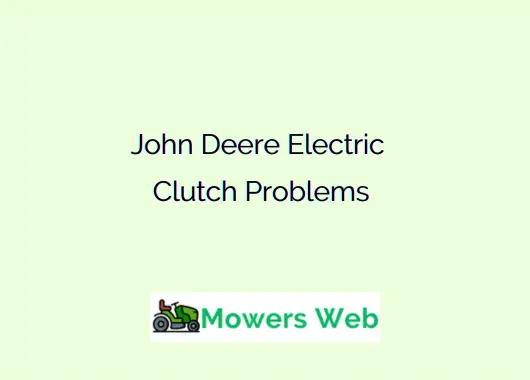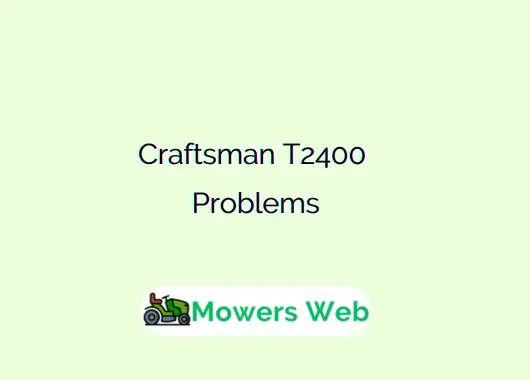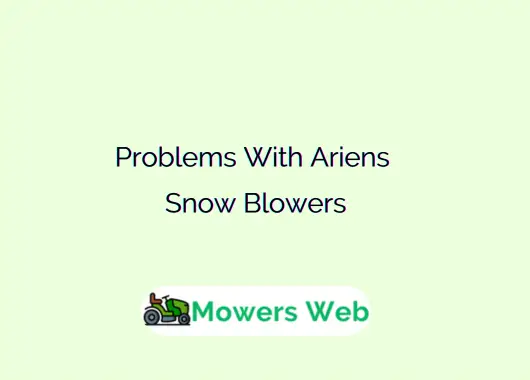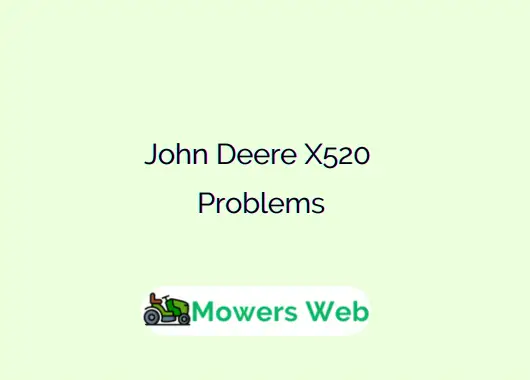The electric clutch, also known as the power take-off (PTO) clutch, is a critical component that engages and disengages the blades or other attachments.
In this blog post, we’ll explore the common causes, symptoms, and solutions for John Deere electric clutch problems, offering practical advice for owners and operators.
John Deere Electric Clutch Problems
1. Failure to Engage: The PTO does not activate when the switch is turned on, meaning the blades or attachment do not spin. This could indicate an electrical failure or a worn-out clutch.
2. Intermittent Engagement: The clutch engages sporadically or cuts out during operation, which can be caused by loose wiring, a failing clutch coil, or voltage issues.
3. Overheating or Burning Smell: A burning smell or excessive heat from the clutch area suggests the clutch is slipping or overloaded, potentially due to improper adjustment or wear.
4. Unusual Noises: Grinding, rattling, or clicking sounds when the PTO is engaged may indicate worn clutch plates, bearings, or debris in the clutch assembly.
5. Blown Fuses or Tripped Breakers: Repeatedly blown fuses or tripped circuit breakers related to the PTO system point to an electrical short or overload in the clutch circuit.
Related Will a Bad PTO Clutch Cause Power Loss?(Explained)
Solutions and Repairs
1. Tighten or Replace Electrical Connections: Clean and tighten any loose or corroded connections. Replace damaged wiring or terminals to restore proper electrical flow.
2. Adjust the Air Gap: If the air gap is out of specification, adjust it by loosening the clutch mounting bolts and inserting shims or spacers as needed. Refer to the manual for exact procedures.
3. Replace the Clutch: If the clutch coil, plates, or bearings are worn, replace the entire clutch assembly. John Deere OEM parts are recommended for compatibility and reliability.
4. Upgrade the Battery or Charging System: A weak battery or alternator can cause voltage issues. Test and replace the battery if necessary, and ensure the charging system is functioning correctly.
5. Regular Maintenance: Prevent future issues by keeping the clutch area clean, avoiding overloading the equipment, and following the recommended maintenance schedule. Lubricate moving parts and inspect the clutch regularly for wear.
Related How to Remove PTO Clutch Bolt(In 5 Quick Steps)
Common Causes of Electric Clutch Problems
1. Electrical Issues: The clutch relies on a consistent electrical supply. Faulty wiring, loose connections, corroded terminals, or a weak battery can disrupt the current, preventing proper engagement. A failing PTO switch or relay can also be the culprit.
2. Worn Clutch Components: Over time, the clutch plates, bearings, or coil can wear out, especially with heavy use or improper maintenance. Worn components reduce the clutch’s ability to engage smoothly or hold power.
3. Improper Air Gap Adjustment: The air gap between the clutch rotor and armature must be within the manufacturer’s specifications (typically 0.012–0.018 inches). If the gap is too wide or too narrow, the clutch may not engage properly or may overheat.
4. Overloading the System: Operating the equipment beyond its capacity, such as mowing thick grass or using heavy attachments, can strain the clutch, leading to premature wear or failure.
5. Moisture and Debris: Exposure to moisture, dirt, or grass clippings can cause corrosion or buildup in the clutch assembly, affecting its performance. This is particularly common in machines used in wet or dusty environments.
Related Mahindra Tractor PTO Problems (5 Issues + Solutions)
Diagnosing Electric Clutch Problems
1. Check the Electrical System: Use a multimeter to test the battery voltage (should be at least 12.6V when fully charged) and ensure the PTO switch and wiring are intact. Inspect for corrosion or loose connections at the clutch, switch, and battery terminals.
2. Inspect the Clutch Assembly: Visually check the clutch for signs of wear, overheating, or debris buildup. Measure the air gap using a feeler gauge and compare it to the specifications in your John Deere manual.
3. Test the Clutch Coil: Use a multimeter to check the resistance of the clutch coil (typically 2–5 ohms, depending on the model). A reading outside this range indicates a faulty coil.
4. Verify PTO Switch and Relay: Test the PTO switch and relay for continuity. A faulty switch or relay can prevent the clutch from receiving power.
Related Symptoms of Bad Ignition Coil on Lawn Mower(6 Commons)
Preventive Tips
To minimize electric clutch problems, adopt these practices:
- Routine Inspections: Check the clutch and electrical system before each season or after heavy use.
- Proper Storage: Store equipment in a dry, sheltered area to prevent moisture-related damage.
- Follow Load Limits: Avoid pushing the machine beyond its rated capacity.
- Use Genuine Parts: Always use John Deere-approved parts for repairs to ensure compatibility and longevity.
Related Low Oil Symptoms in Lawn Mowers (Don’t Ignore These Signs)
When to Seek Professional Help
Some clutch issues, such as minor electrical fixes or air gap adjustments, can be handled by owners with basic mechanical skills. However, complex problems like clutch replacement or diagnosing electrical shorts may require professional assistance. Contact a certified John Deere technician or service center if you’re unsure or lack the tools for repairs.
Final words
John Deere electric clutch problems can be frustrating, but with proper diagnosis and maintenance, they can be resolved effectively. By understanding the symptoms, causes, and solutions, owners can keep their equipment running smoothly and avoid costly downtime.
Regular maintenance, timely repairs, and adherence to manufacturer guidelines are key to extending the life of your John Deere machine’s electric clutch. If you encounter persistent issues, don’t hesitate to consult a professional to ensure your equipment stays in top condition.




